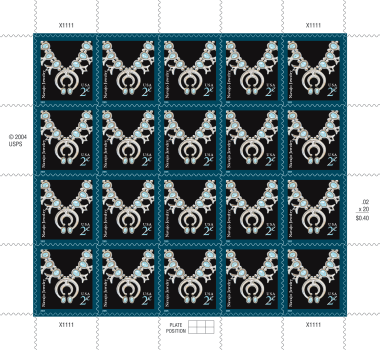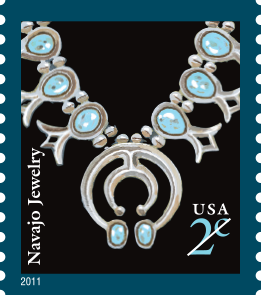
About This Stamp
On August 20, 2004, the U.S. Postal Service issued a two-cent definitive stamp in the American Design series. The Navajo Jewelry stamp features a painted detail of a Navajo silver and turquoise necklace with sand-cast "squash blossoms."
The Navajo learned to work silver from itinerant Mexican plateros, or silversmiths, in the mid-19th century and soon turned the craft of jewelry making into a fine art. Well before the turn of the 20th century, jewelry making had become, along with the older tradition of weaving, an important aspect of Navajo material culture. Early Navajo silversmiths were especially known for their bracelets and bow guards, or k’eet’ohs; concha belts; and necklaces. The squash blossom necklace, in particular, became and remains very popular in the Southwest. Artistic expression continues to flourish among Navajo silversmiths today. They use silver, gold, and a variety of semi-precious and precious stones to create traditional and contemporary designs.
A squash blossom necklace is typically composed of silver beads resembling stylized blossoms, with a single crescent-shaped pendant at the center. Some squash blossom necklaces are made entirely of silver, particularly older examples; others combine silver and turquoise or silver and coral. The "squash blossom" design is based on a Spanish-Mexican trouser ornament that was actually a stylized version of the pomegranate blossom. The Navajo name for this type of necklace has nothing to do with either squash or pomegranate blossoms, however; it simply means "round beads that spread out."
The Navajo word for the central crescent-shaped pendant is názhah, meaning \"curve,\" but such pendants are usually referred to simply as "najas." Initially, the crescent-shaped naja pendants were probably based on Spanish colonial bridle ornaments, which in turn were derived from a Moorish crescent design.
Around 1880, Navajo silversmiths began setting stones—particularly large, rough-cut nuggets of turquoise—into silver. Turquoise was, and still is today, highly regarded and appreciated in the Southwest. To many Southwest tribes, turquoise is a sacred stone and the Navajo, who use it lavishly in their jewelry, believe that wearing turquoise brings good fortune.
The squash blossom necklace depicted on the stamp is believed to have been made sometime during the 1940s or 1950s. Set with polished blue turquoise nuggets, its sand-cast abstract "squash blossoms" are an unusual feature; more typically, squash blossom beads consist of three separate parts soldered together. (In sand-casting, a design is carved into two pieces of soft rock that, when fitted together, act as a mold into which melted silver is poured. After the silver is removed, it is filed and polished.)
With the issuance of the five-cent American Toleware stamp on May 31, 2002, the Postal Service launched a series of definitive stamps featuring examples of the rich diversity of American design. (Definitives are regular issues of postage stamps, usually sold over long periods of time.) The American Design series showcases objects from various regions, eras, and ethnic cultures that combine utility with beauty and function with form. It replaced the long-running Transportation series, which was issued from 1981 through 1995. The American Design stamps will range in denomination from one through ten cents: the ten-cent American Clock and the one-cent Tiffany Lamp were issued in 2003; the four-cent Chippendale Chair was issued on March 5, 2004.
Stamp Art Director, Stamp Designer

Derry Noyes
For more than 40 years Derry Noyes has designed and provided art direction for close to 800 United States postage stamps and stamp products. She holds a bachelor of arts degree from Hampshire College and a master of fine arts degree from Yale University.
Noyes worked as a graphics designer at Beveridge and Associates, a Washington, D.C., firm, until 1979 when she established her own design firm, Derry Noyes Graphics. Her clients have included museums, corporations, foundations, and architectural and educational institutions. Her work has been honored by American Illustration, the Art Directors Club of Metropolitan Washington, Communication Arts, Critique magazine, Graphis, Creativity International, and the Society of Illustrators.
Before becoming an art director for the U.S. Postal Service, she served as a member of the Citizens' Stamp Advisory Committee from 1981 to 1983.
Noyes is a resident of Washington, D.C.
Stamp Artist

Lou Nolan
Longtime stamp artist Lou Nolan studied fine art at the Corcoran School of Art in Washington, DC, his hometown, and graduated from New York's Parsons School of Design in 1952. After working as a book designer and illustrator in New York, he returned to Washington to begin a freelance career. Following a ten-year partnership at a graphic design firm, Nolan returned to freelancing. By the time he retired in 1995, he had created designs for NASA, the Smithsonian Institution, each branch of the U.S. Armed Forces, and many federal agencies. His work was honored by the Art Directors Club of New York and Print magazine. He won gold and silver medals from the Art Directors Club of Metropolitan Washington.
Nolan designed many stamp products for the U.S. Postal Service® and more than a dozen stamps, including the first five in the American Design series that began in 2002. Some of these stamps have been reprinted in recent years including the Chippendale Chair (2007, 2014), the American Clock (2008), and the Tiffany Lamp (2007, 2009).
Mr. Nolan died on October 24, 2008.
